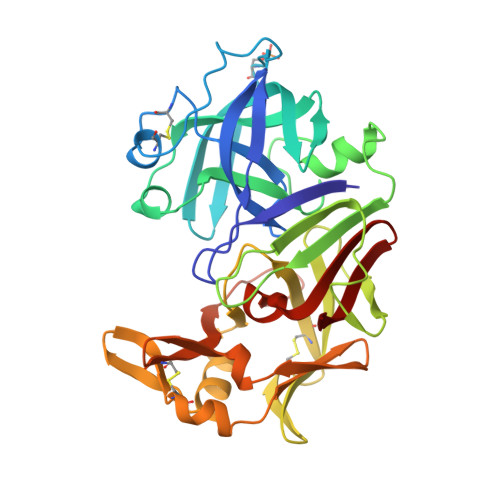Molecular and crystal structures of monoclinic porcine pepsin refined at 1.8 A resolution.
Sielecki, A.R., Fedorov, A.A., Boodhoo, A., Andreeva, N.S., James, M.N.(1990) J Mol Biol 214: 143-170
- PubMed: 2115087
- DOI: https://doi.org/10.1016/0022-2836(90)90153-D
- Primary Citation of Related Structures:
4PEP - PubMed Abstract:
The molecular structure of the archetypal aspartic proteinase, porcine pepsin (EC 3.4.23.1), has been refined using data collected from a single monoclinic crystal on a twin multiwire detector system to 1.8 A resolution. The current crystallographic R-factor (= sigma parallel to Fo/-/Fc parallel to/sigma/Fo/) is 0.174 for the 20,519 reflections with /Fo/ greater than or equal to 3 sigma (Fo) in the range 8.0 to 1.8 A (/Fo/ and /Fc/ are the observed and calculated structure factor amplitudes respectively). The refinement has shown conclusively that there are only 326 amino acid residues in porcine pepsin. Ile230 is not present in the molecule. The two catalytic residues Asp32 and Asp215 have dispositions in porcine pepsin very similar to the dispositions of the equivalent residues in the other aspartic proteinases of known structure. A bound solvent molecule is associated with both carboxyl groups at the active site. No bound ethanol molecule could be identified conclusively in the structure. The average thermal motion parameter of the residues that comprise the C-terminal domain of pepsin is approximately twice that of the residues in the N-terminal domain. Comparisons of the tertiary structure of pepsin with porcine pepsinogen, penicillopepsin, rhizopus pepsin and endothia pepsin reveal that the N-terminal domains are topographically more similar than the conformationally flexible C-terminal domains. The conformational differences may be modeled as rigid-body movements of "reduced" C-terminal domains (residues 193 to 212 and 223 to 298 in pepsin numbering). A similar movement of the C-terminal domain of endothia pepsin has been observed upon inhibitor binding. A phosphoryl group covalently attached to Ser68 O gamma has been identified in the electron density map of porcine pepsin. The low pKa1 value for this group, coupled with unusual microenvironments for several of the aspartyl carboxylate groups, ensures a net negative charge on porcine pepsin in a strongly acid medium. Thus, there is a structural explanation for the very early observations of "anodic migration" of porcine pepsin at pH 1. In the crystals, the molecules are packed tightly into a monoclinic unit cell. There are 190 direct contacts (less than or equal to 4.0 A) between a central pepsin molecule and the five unique symmetry-related molecules surrounding it in the crystalline lattice. The tight packing in this cell makes pepsin's active site and binding cleft relatively inaccessible to substrate analogs or inhibitors.
Organizational Affiliation:
Department of Biochemistry, University of Alberta, Edmonton, Canada.















